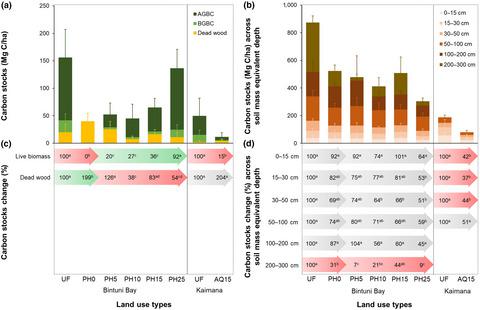当前位置:
X-MOL 学术
›
Glob. Change Biol.
›
论文详情
Our official English website, www.x-mol.net, welcomes your
feedback! (Note: you will need to create a separate account there.)
Mangrove blue carbon stocks and dynamics are controlled by hydrogeomorphic settings and land-use change.
Global Change Biology ( IF 10.8 ) Pub Date : 2020-03-24 , DOI: 10.1111/gcb.15056 Sigit D Sasmito 1, 2 , Mériadec Sillanpää 3, 4 , Matthew A Hayes 5 , Samsul Bachri 6 , Meli F Saragi-Sasmito 2 , Frida Sidik 7 , Bayu B Hanggara 2 , Wolfram Y Mofu 8 , Victor I Rumbiak 8 , Hendri 8 , Sartji Taberima 6 , Suhaemi 9 , Julius D Nugroho 8 , Thomas F Pattiasina 9 , Nuryani Widagti 7 , Barakalla 10 , Joeni S Rahajoe 11 , Heru Hartantri 11 , Victor Nikijuluw 10 , Rina N Jowey 8 , Charlie D Heatubun 8, 12, 13 , Philine Zu Ermgassen 14 , Thomas A Worthington 15 , Jennifer Howard 16 , Catherine E Lovelock 17 , Daniel A Friess 3 , Lindsay B Hutley 1 , Daniel Murdiyarso 2, 18
Global Change Biology ( IF 10.8 ) Pub Date : 2020-03-24 , DOI: 10.1111/gcb.15056 Sigit D Sasmito 1, 2 , Mériadec Sillanpää 3, 4 , Matthew A Hayes 5 , Samsul Bachri 6 , Meli F Saragi-Sasmito 2 , Frida Sidik 7 , Bayu B Hanggara 2 , Wolfram Y Mofu 8 , Victor I Rumbiak 8 , Hendri 8 , Sartji Taberima 6 , Suhaemi 9 , Julius D Nugroho 8 , Thomas F Pattiasina 9 , Nuryani Widagti 7 , Barakalla 10 , Joeni S Rahajoe 11 , Heru Hartantri 11 , Victor Nikijuluw 10 , Rina N Jowey 8 , Charlie D Heatubun 8, 12, 13 , Philine Zu Ermgassen 14 , Thomas A Worthington 15 , Jennifer Howard 16 , Catherine E Lovelock 17 , Daniel A Friess 3 , Lindsay B Hutley 1 , Daniel Murdiyarso 2, 18
Affiliation

|
Globally, carbon-rich mangrove forests are deforested and degraded due to land-use and land-cover change (LULCC). The impact of mangrove deforestation on carbon emissions has been reported on a global scale; however, uncertainty remains at subnational scales due to geographical variability and field data limitations. We present an assessment of blue carbon storage at five mangrove sites across West Papua Province, Indonesia, a region that supports 10% of the world's mangrove area. The sites are representative of contrasting hydrogeomorphic settings and also capture change over a 25-years LULCC chronosequence. Field-based assessments were conducted across 255 plots covering undisturbed and LULCC-affected mangroves (0-, 5-, 10-, 15- and 25-year-old post-harvest or regenerating forests as well as 15-year-old aquaculture ponds). Undisturbed mangroves stored total ecosystem carbon stocks of 182-2,730 (mean ± SD: 1,087 ± 584) Mg C/ha, with the large variation driven by hydrogeomorphic settings. The highest carbon stocks were found in estuarine interior (EI) mangroves, followed by open coast interior, open coast fringe and EI forests. Forest harvesting did not significantly affect soil carbon stocks, despite an elevated dead wood density relative to undisturbed forests, but it did remove nearly all live biomass. Aquaculture conversion removed 60% of soil carbon stock and 85% of live biomass carbon stock, relative to reference sites. By contrast, mangroves left to regenerate for more than 25 years reached the same level of biomass carbon compared to undisturbed forests, with annual biomass accumulation rates of 3.6 ± 1.1 Mg C ha-1 year-1 . This study shows that hydrogeomorphic setting controls natural dynamics of mangrove blue carbon stocks, while long-term land-use changes affect carbon loss and gain to a substantial degree. Therefore, current land-based climate policies must incorporate landscape and land-use characteristics, and their related carbon management consequences, for more effective emissions reduction targets and restoration outcomes.
中文翻译:

红树林的蓝碳储量和动态受水文地貌环境和土地利用变化的控制。
在全球范围内,由于土地利用和土地覆被变化(LULCC),富含碳的红树林被砍伐和退化。在全球范围内,已经报道了红树林砍伐对碳排放的影响;但是,由于地理变异性和现场数据的局限性,不确定性仍在国家以下范围内。我们对印尼西巴布亚省五个红树林场所的蓝碳储量进行了评估,该地区支持着世界红树林面积的10%。这些位点代表了对比的水文地貌环境,还捕获了25年的LULCC时序序列中的变化。在255个样地上进行了实地评估,覆盖了未受干扰和受LULCC影响的红树林(0、5、10、15和25岁的采伐后或再生林以及15岁的水产养殖池塘) )。未受干扰的红树林的总生态系统碳储量为182-2,730(平均值±标准偏差:1,087±584)Mg C / ha,其中很大的差异是由水文地貌环境驱动的。在河口内陆(EI)红树林中发现了最高的碳储量,其次是沿海内陆,沿海沿海边缘和EI森林。尽管死木密度相对于未受干扰的森林而言,森林采伐并没有显着影响土壤碳储量,但它确实清除了几乎所有的生物量。相对于参考地点,水产养殖转化去除了60%的土壤碳储量和85%的活生物质碳储量。相比之下,与未受干扰的森林相比,留给再生超过25年的红树林达到了相同的生物量碳水平,年生物量累积速率为3.6±1.1 Mg C ha-1 year-1。这项研究表明,水文地貌环境控制着红树林蓝色碳储量的自然动态,而长期的土地利用变化则在很大程度上影响碳的损失和获取。因此,当前的陆基气候政策必须纳入景观和土地利用特征及其相关的碳管理后果,以实现更有效的减排目标和恢复成果。
更新日期:2020-04-22
中文翻译:

红树林的蓝碳储量和动态受水文地貌环境和土地利用变化的控制。
在全球范围内,由于土地利用和土地覆被变化(LULCC),富含碳的红树林被砍伐和退化。在全球范围内,已经报道了红树林砍伐对碳排放的影响;但是,由于地理变异性和现场数据的局限性,不确定性仍在国家以下范围内。我们对印尼西巴布亚省五个红树林场所的蓝碳储量进行了评估,该地区支持着世界红树林面积的10%。这些位点代表了对比的水文地貌环境,还捕获了25年的LULCC时序序列中的变化。在255个样地上进行了实地评估,覆盖了未受干扰和受LULCC影响的红树林(0、5、10、15和25岁的采伐后或再生林以及15岁的水产养殖池塘) )。未受干扰的红树林的总生态系统碳储量为182-2,730(平均值±标准偏差:1,087±584)Mg C / ha,其中很大的差异是由水文地貌环境驱动的。在河口内陆(EI)红树林中发现了最高的碳储量,其次是沿海内陆,沿海沿海边缘和EI森林。尽管死木密度相对于未受干扰的森林而言,森林采伐并没有显着影响土壤碳储量,但它确实清除了几乎所有的生物量。相对于参考地点,水产养殖转化去除了60%的土壤碳储量和85%的活生物质碳储量。相比之下,与未受干扰的森林相比,留给再生超过25年的红树林达到了相同的生物量碳水平,年生物量累积速率为3.6±1.1 Mg C ha-1 year-1。这项研究表明,水文地貌环境控制着红树林蓝色碳储量的自然动态,而长期的土地利用变化则在很大程度上影响碳的损失和获取。因此,当前的陆基气候政策必须纳入景观和土地利用特征及其相关的碳管理后果,以实现更有效的减排目标和恢复成果。











































 京公网安备 11010802027423号
京公网安备 11010802027423号